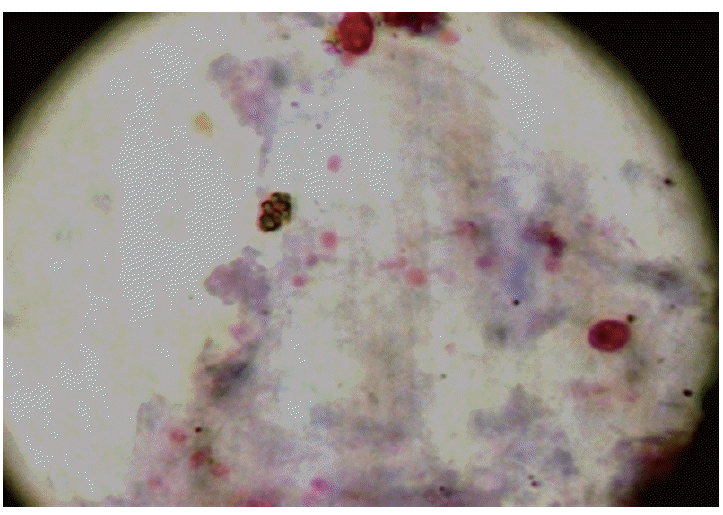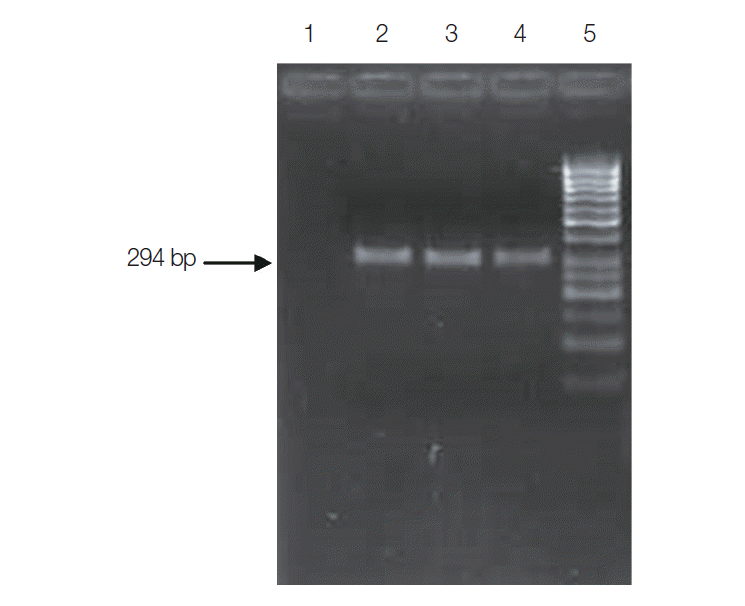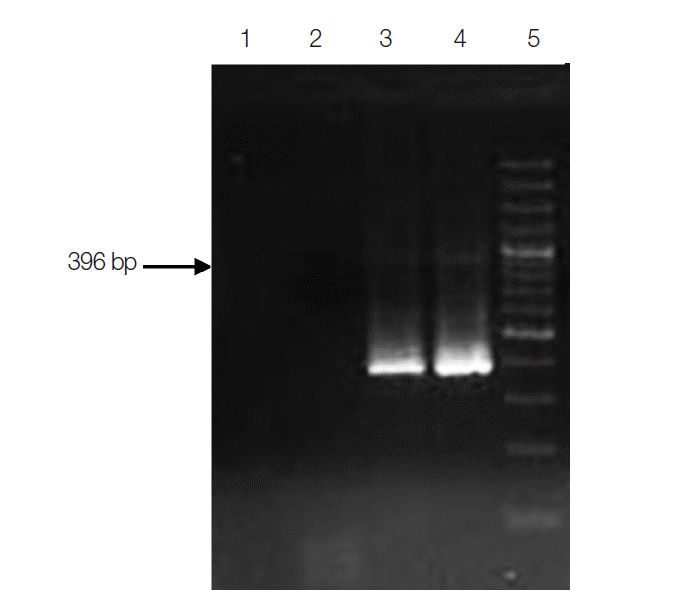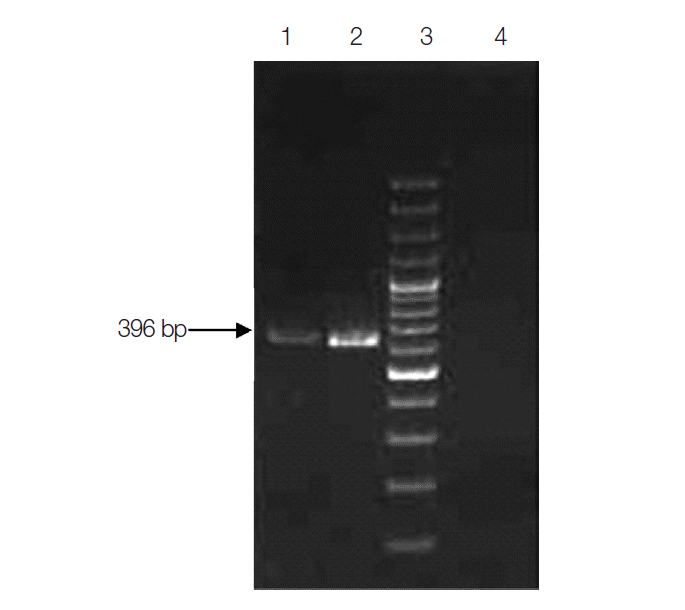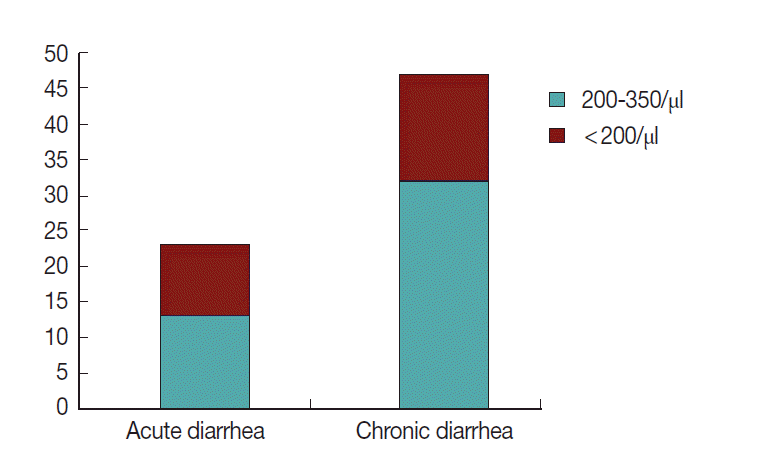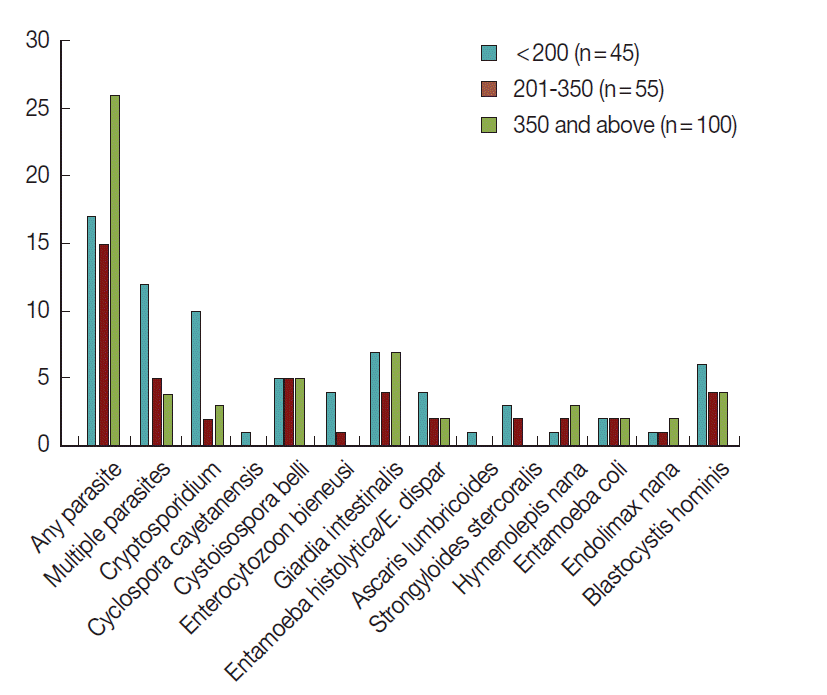Abstract
Intestinal parasitic infections are one of the major causes of diarrhea in human immunodeficiency virus (HIV) seropositive individuals. Antiretroviral therapy has markedly reduced the incidence of many opportunistic infections, but parasite-related diarrhea still remains frequent and often underestimated especially in developing countries. The present hospital-based study was conducted to determine the spectrum of intestinal parasitosis in adult HIV/AIDS (acquired immunodeficiency syndrome) patients with or without diarrhea with the levels of CD4+ T-cell counts. A total of 400 individuals were enrolled and were screened for intestinal parasitosis. Of these study population, 200 were HIV seropositives, and the remaining 200 were HIV uninfected individuals with or without diarrhea. Intestinal parasites were identified by using microscopy as well as PCR assay. A total of 130 (32.5%) out of 400 patients were positive for any kinds of intestinal parasites. The cumulative number of parasite positive patients was 152 due to multiple infections. A significant association of Cryptosporidium (P<0.001) was detected among individuals with CD4+ T-cell counts less than 200 cells/μl.
-
Key words: Cryptosporidium, intestinal parasite, HIV/AIDS, antiretroviral therapy, parasite, diarrhea, India
INTRODUCTION
Epidemiological surveillance data shows an estimated 2.6 million (2.3-2.8 million) people are newly infected with HIV and is also believed that an average of 1.8 million (1.6-2.1 million) people die annually because of AIDS worldwide. Intestinal parasitic infections are one of the most frequent causes of morbidity and mortality in HIV-infected patients (UNAIDS). A consistent association between HIV infection and intestinal parasitosis has been reported in tropical regions [
1] and more so in patients with CD4
+ T-cell counts less than 200 cells/mm
3 [
2]. Data on correlation of HIV/AIDS with enteric parasitic infection in South Asian region have reported association of several species of pathogenic protozoa such as
Cryptosporidium spp.,
Cystoisospora belli, Cyclospora cayetanensis, Giardia lamblia, Entamoeba histolytica, Blastocystis hominis, and microsporidia species [
3]. The clinical spectrum caused by intestinal parasites among HIV positive patients ranges from asymptomatic to severe infections leading to chronic diarrhea, dehydration, and malabsorption [
4]. It has also been observed that antiretroviral therapy (ART) can restore immunity by increasing both memory and naive CD4
+ cells against many opportunistic pathogens [
5,
6]. The use of ART has dramatically reduced the incidence of diarrhea due to
Cryptosporidium spp.,
C. belli, and microsporidia primarily due to immune reconstitution after ART initiation. In the absence of a vaccine and affordable ART in many parts of the world, people living with HIV/AIDS, especially in developing countries, remain at considerable risk for various opportunistic infections [
6]. In this context, the present study was undertaken with an objective of assessing the presence of intestinal parasitic infections in HIV seropositive patients and its correlation with CD4
+ T-cell count in India.
MATERIALS AND METHODS
The study was conducted from June 2010 to June 2013 and participating individuals were enrolled from both in-patient and out-patient departments of our tertiary health care centre, New Delhi, India. Stool samples were obtained both from HIV seropositive patients on ART termed as “on ART HIV seropositives with diarrhea (n=100)” and “ART naive HIV seropositive patients without diarrhea (n=100)” (
Table 1). Both of these groups of patients were enrolled as “cases”. The “on-ART HIV seropositive patients with diarrhea” included 45 patients with CD4
+ T-cell count less than 200 cells/µl and 55 patients with CD4
+ T-cell count between 200-350 cells/µl. Whereas all “ART naive HIV seropositive patients without diarrhea (n=100) had CD4
+ T-cell count of more than 350 cells/µl. In addition to above 2 groups, 200 HIV uninfected patients comprising of 100 patients with diarrhea and 100 patients without diarrhea were taken as “controls”. Diarrhea was defined as the passage of liquid or unformed stool at an increased frequency according to WHO in 2009 (
http://www.who.int/topics/diarrhoea/en/) and was further categorized as ‘acute’, ‘persistent’, and ‘chronic’ if lasts for duration of 7 days, 8-15 days, and for more than 15 days, respectively. In the present study, patients with complaints of persistent and chronic diarrhea were put together as chronic diarrhea.
For microscopic examinations, stool sample processing was carried out depending on the consistency of the samples received. In case of watery stools, direct wet-mounts (both in normal saline and 3% Lugol’s iodine) were prepared and a fecal smear was made. For the formed stools, formol-ether concentration technique was used [
7] and the sediment was used for preparation of wet-mount and fecal smears. Modified Ziehl-Neelsen (MAF) staining was performed on fecal smears to detect oocysts of
Cryptosporidium spp.,
C. cayetanensisi, and
C. belli [
8] and modified trichrome staining for the detection of microsporidia species [
9].
Diagnostic PCR assay was carried out targeting 18S rRNA gene of the genus
Cryptosporidium [
10,
11],
C. cayetanensisi [
11],
C. belli [
12], and
Enterocytozoon bieneusi (
E. bieneusi) [
13] using published primers. Amplified PCR products were visualized in 2% gels stained with ethidium bromide. PCR assay for the genus
Cryptosporidium was optimized using an equal mixture of forward primer CPB-DIAGF (5´-AGCTCGTAGTTGGATTTCTG-3´) and reverse primer CPB-DIAGR (5´-TAAGGTGCTGAAGGAGTAAGG-3´) in a volume of 25 µl. PCR assay was performed using an initial denaturation temperature of 94˚C for 5 min followed by 35 cycles of denaturation at 94˚C for 30 sec. Annealing was done at 56˚C for 30 sec followed by extension at 72˚C for 1 min. Final extension was given for 10 min at 72˚C. The amplified PCR product was of size 435 bp.
PCR assay for the detection of C. cayetanensisi was optimized using nested PCR assay. Oligonucleotide primer F1E (5´-TACCCAATGAAAACAGTT-3´) was used as the forward primer and R2B (5´-CAGGAGAAGCCAAGGTAG-3´) as the reverse primer for the external round of PCR assay. The external round of PCR assay amplified a primary amplicon of 636 bp, whereas the set of internal primer pair F3E (5´-CCTTCCGCGCTTCGCTGCGT-3´) and R4B (5´-CGTCTTCAAACCCCCTACTG-3´) amplified a 294 bp region. The PCR assay procedure consisted of initial denaturation at 94˚C for 5 min followed by 35 cycles of denaturation at 94˚C for 30 sec, annealing at 53˚C for 30 sec, extension at 72˚C for 90 sec, and a final extension at 72˚C for 10 min. PCR cycling condition for the nested round was the same as the external round except for change in annealing temperature to 61˚C.
PCR assay for the detection of C. belli was optimized as a nested PCR assay. The external round PCR assay was carried out using IsoFO (5´-GTGCCTCTTCCTCTGGAAGG-3´) as the forward primer and IsoRO (5´-GCACTCCACCCAGTTAAGTGC-3´) as the reverse primer. External round amplified a PCR product of 559 bp. IsoFI (5´-CGATGGATCATTCAAGTTTC-3´) and IsoRI (5´-ACCACGTACACACCCCTAAG-3´) were used as forward and reverse primers for the internal round. Internal round amplified a PCR product of size 396 bp. The PCR protocol consisted of initial denaturation at 94˚C for 3 min followed by 35 cycles of denaturation at 94˚C for 1 min, annealing at 61˚C for 2 min, extension at 72˚C for 3 min, and a final extension at 72˚C for 10 min. PCR cycling condition for the nested round was the same as the external round except for changes in annealing temperature to 57˚C.
PCR assay for exclusive detection of E. bieneusi was optimized as a single round PCR assay using an equal mixture of forward primers EBIEF1 (5´-GAAACTTGTCCACTCCTTACG-3´) and reverse primer EBIER1 (5´-CCATGCACCACTCCTGCCATT-3´) amplifying a region of 607 bp. The PCR protocol consisted of initial denaturation at 94˚C for 5 min followed by 35 cycles of denaturation at 94˚C for 30 sec, annealing at 56˚C for 30 sec, extension at 72˚C for 90 sec, and a final extension at 72˚C for 10 min.
Ethical approval was obtained from the institutional ethics committee before the commencement of the study. All participants were informed that the procedure used did not pose any potential risk and their identities, and personal particulars will be kept confidential. During the meetings, enrolled individuals were also informed that their participation is absolutely voluntary, and they can withdraw from the study at any given point of time without explaining any reasons.
Analyses were done using STATA software, version 11 (Stata-Corp. College Station, Texas, USA). Descriptive statistics were carried out. Odds ratio (OR) and 95% confidence intervals (CI) were calculated by using a bi-variable logistic regression. Tests were considered significant at P-value<0.05.
RESULTS
The median age for the cases (n=200) and controls (n=200) was 36 years (range 19-59) and 39 years (19-65), respectively (
Table 1). Morphologically, a total of 123 out of 400 patients were positive for any kinds of intestinal parasites. The cumulative number of positive patients was 145 because of multiple infections. The parasite species included
Cryptosporidium spp. (n=13),
C. cayetanensisi (n=3),
C. belli (n=15),
Strongyloides stercoralis (n=5),
G. lamblia (n=32),
E. histolytica/E. dispar (n=15),
Ascaris lumbricoides (n=2),
Hymenolepis nana (n=10),
Entamoeba coli (n=11),
Endolimax nana (n=9), and
B. hominis (n=30). The environmentally resistant oocysts of
Cryptosporidium spp. and
C. cayetanensisi measured 4-6 µm and 8- 10 µm, respectively (
Fig. 1A,
B), whereas, oocysts of
C. belli were oval and measured 20-30×10-15 µm in size (
Fig. 1C). Spores of microsporidia appeared as small pink dots measuring 1-2 µm in size (
Fig. 2). All the measurements were done using the standard micrometry technique.
Subjecting all the clinical specimens to PCR assays, 2 additional cases of
Cryptosporidium and 5 cases of
E. bieneusi were detected. Hence, a total of 130 (32.5%) out of 400 patients were positive for any kinds of intestinal parasites using both microscopic examinations and PCR assay. The cumulative number of positive patients was 152. Of these, 43 (28%) were infected with opportunistic, 59 (39%) were with non-opportunistic pathogenic, and 50 (33%) were with non-pathogenic parasites (
Table 2). PCR product of sizes 435 bp, 294 bp, 396 bp, and 607 bp were obtained for
Cryptosporidium spp.,
C. cayetanensisi,
C. belli, and
E. bieneusi, respectively (
Figs. 3-
6).
In this group, 42% (42/100) had acute and 58% (58/100) had chronic diarrhea (
Fig. 7). Of 100 patients, 49 (49.0%) were positive for any kinds of parasites. The cumulative number of parasite positive patients was 70 because of multiple parasite infections, and among them 33 (47%) were opportunistic parasite positives, 21 (30%) were non-opportunistic pathogenic parasite positives, and 16 (23%) were non-pathogenic parasite positives (
Table 3). Of these 70 patients, 23 (33%) and 47 (67%) were having acute and chronic diarrhea, respectively (
Fig. 8). Although the difference between these 2 was 2-fold, it was statistically not significant.
Of the 49 HIV seropositive patients with diarrhea on ART who had parasitic infections, 29 (59.2%) were patients with CD4
+ T-cell count less than 200 cells/µl and 20 (40.8%) were with CD4
+ T-cell count between 200-350 cells/µl (
Fig. 9). Increased frequencies of multiple parasites were observed in individuals with CD4
+ T-cell count less than 200 cells/µl (OR=3.63; 95% CI, 1.17-11.28;
P=0.02). In addition, higher frequency of cryptosporidiosis was detected in individuals with CD4
+ T-cell count less than 200 cells/µl (OR=8.5; 95% CI, 2.75-26.66).
In this group, 27 (27.0%) of 100 patients were positive for any kinds of parasites. The cumulative number of parasite infections was 28. These 28 intestinal parasites included 8 (29%) opportunistic parasites, 12 (42%) non-opportunistic parasites, and 8 (29%) non-pathogenic parasites (
Table 3). These patients mostly presented with single parasitic infections, except 1 who showed multiple parasitic infections (
Fig. 9).
In this group, 40 (40.0%) of 100 patients with diarrhea and 14 (14.0%) of 100 patients without diarrhea were positive for any kinds of parasites. Amongst the individuals with diarrhea, 74% had acute and 26% had chronic diarrhea (
Fig. 7). Two (5.0%) of 40 cases were positive for
C. cayetanensisi (opportunistic parasites), and 20 (50%) were with non-opportunistic intestinal parasites. The remaining 18 (45%) were with non-pathogenic parasites. However, in HIV uninfected patients without diarrhea, 6 (42.0%) of the 14 cases were with non-opportunistic parasites, and 8 (58%) were with non-pathogenic parasites (
Table 3). There were no multiple infections in these groups.
It was noticeable that
Cryptosporidium spp. and
C. belli were significantly associated with HIV seropositive patients compared to HIV uninfected (
Table 2). When the spectrum of intestinal parasites was compared between “on-ART HIV seropositives with diarrhea” (n=100) and “HIV uninfected patients with diarrhea” (n=100), it was observed that
Cryptosporidium spp. and
C. belli were significantly associated with HIV seropositive patients (
P <0.05) (
Table 3). However, no significant association of parasitic infections was observed between ART naive HIV seropositives without diarrhea (n=100) and HIV uninfected patients (non HIV) without diarrhea.
DISCUSSION
Deterioration of immune system caused by HIV makes an individual extremely susceptible to numerous opportunistic infections. Almost 80% of the AIDS patients die because of AIDS related opportunistic infections including intestinal parasitic infections rather than disease per se [
14]. The present study primarily intended to determine opportunistic, non-opportunistic, and non-pathogenic intestinal parasites in both diarrheic and non-diarrheic HIV seropositive patients.
To circumvent the limitations of conventional microscopic detection methods, all our clinical specimens were subjected to PCR assays as such assays can detect the presence of a single oocyst in the clinical specimens [
15]. Intestinal parasites that were detected in our study population (n=400) included
Cryptosporidium spp. (3.8%),
C. cayetanensisi (0.8%),
C. belli (3.8%),
E. bieneusi (1.3),
G. intestinalis (8.0%),
E. histolytica/E. dispar (3.8%),
A. lumbricoides (0.5%),
S. stercoralis (1.3%),
H. nana (2.5%),
E. coli (2.8%),
E. nana (2.3%), and
B. hominis (7.5%).
A total of 36 HIV seropositive patients were infected with coccidia and/or microsporidia implicating a clear association of these parasites with HIV seropositive patients. Similar reports are available both from developed and developing countries [
16-
18]. In a study conducted on HIV seropositive patients in Laos Peoples’ Democratic Republic, different intestinal parasites were identified in 78.8% of the patients; however, classical opportunistic pathogens (
Cryptosporidium,
C. belli,
C. cayetanensisi, and microsporidia) were detected at a much lower frequency (6.6%, 4.4%, 2.2%, and 2.9%, respectively) [
19].
Cryptosporidium as a cause of diarrhea in HIV seropositive patients has been reported from India [
20], and more importantly in patients with CD4
+ T-cell counts of less than 200 cells/µl [
21]. In agreement with the above mentioned studies and others from developing countries [
22-
24], it can be attributed that increased susceptibility of HIV seropositive patients to acquire particular parasitic infections is associated with CD4
+ T-cell count often at less than 200 cells/µl. At a higher CD4
+ T-cell count, generally spontaneous clearing of the parasites take place. In a resource poor setting like ours, patients usually are unaware of the disease and go undiagnosed for long periods and seek for medical consultation much later in the course of the disease. Consequently, patients usually present with profound, persistent, and multiple parasitic infections. Poor personal hygiene, low socioeconomic status, and contaminated drinking water are the additional factors responsible for high frequency of cryptosporidiosis [
25].
In our study,
Cryptosporidium spp. were identified as the predominant etiology of diarrhea in ‘on-ART’ patients, and this can probably be explained by the fact that these patients were diarrheic and had low CD4
+ T-cell counts. Another factor that brings to attention is the adherence to the treatment regimen. The effectiveness of ART highly depends on good compliance of the treatment [
26,
27]; however; low level of adherence to the treatment is a common observation in low income countries. Similar findings have been observed from Ethiopia, where 28.4% of cryptosporidiosis cases and 10% of cystoisosporiasis cases were reported in patients who were receiving ART. A report from France indicated increase of cystoisosporiasis from 0.4 per 1,000 patients in the pre-ART era (1995-1996) to 4.4 per 1,000 patients in the ART era [
28].
Immunosuppression, a consequence of HIV infection favours the occurrence of multiple opportunistic infections [
30]. Multiple parasitic infections have been reported at a frequency of 4.8% [
31] from Africa and 27.2% [
32] from Malaysia. Increased frequency of multiple parasitic infections among HIV seropositive individuals with lower CD4
+ T-cell counts probably allows non interfering co-habitation of these parasites in the infected hosts.
Amongst the HIV seropositive patients with diarrhea, 58% had chronic diarrhea and 42% had acute diarrhea. Diarrhea is an important clinical problem among HIV seropositive individuals and is associated with significant impairments in health and quality of life [
29]. The present study shows that diarrhea is a concern among the participants regardless of their HIV status though it more likely takes chronic course among HIV infected patients than HIV uninfected group.
Increased frequency of intestinal parasitic infections in the present study population certainly warrants necessary intervention. Routine screening of parasitic infections should be made mandatory especially for all asymptomatic HIV seropositive individuals to administer early and specific treatment.
Notes
-
We have no conflict of interest related to this work.
We thank Indian Council of Medical Research (ICMR), Government of India for providing the financial help to carry out the present study. The first author would like to thank Council of Scientific and Industrial Research (CSIR), Government of India, for providing the fellowship grant to conduct this study.
Fig. 1.Modified acid fast staining showing oocysts of (A) Cryptosporidium species (4-8 μm in diameter), (B) Cyclospora cayetanensis (8-10 μm in diameter), and (C) Cystoisospora belli (20-30 by 10-15 μm in size).

Fig. 2.Modified trichrome staining showing spores of microsporidia (1-2 μm in diameter).

Fig. 3.PCR assay for 18S rRNA gene of Cryptosporidium spp. Lane 1, negative control; lanes 2-3, positive samples; lane 4, positive control; lane 5, 100 bp molecular marker; lane 6, blank.

Fig. 4.PCR assay for 18S rRNA gene of Cyclospora cayetanensis. Lane 1, negative control; lanes 2-4, positive samples; lane 5, 50 bp molecular marker.

Fig. 5.PCR assay for internal round of 18S rRNA gene of Cystoisospora belli. Lane 1, blank; lane 2, negative control; lanes 3-4, positive samples; lane 5, 100 bp molecular marker.

Fig. 6.PCR assay for 18S rRNA gene of Enterocytozoon bieneusi (microsporidia). Lane 1, positive control; lane 2, positive sample; lane 3, 100 bp molecular marker; lane 4, negative control.

Fig. 7.No. of patients with acute diarrhea and chronic diarrhea amongst HIV infected and HIV uninfected cases with diarrhea.

Fig. 8.No. of parasites in patients with acute diarrhea and chronic diarrhea stratified on the basis of CD4+ T-cell count among HIV seropositive individuals.

Fig. 9.Distribution of patients in relation to CD4+ T-cell count and the presence of parasites.

Table 1.Demographic details and risk factors of HIV seropositive patients
Table 1.
|
Variables |
No. |
Percentage (%) |
|
Age (Median) in years |
36 |
- |
|
Gender |
|
|
|
Male |
132 |
66 |
|
Female |
68 |
44 |
|
Risk Factor |
|
|
|
Heterosexual |
178 |
89 |
|
Blood Transfusion |
11 |
5 |
|
Needle Prick |
3 |
2 |
|
Unknown |
8 |
4 |
Table 2.Distribution of intestinal parasites between cases and controls
Table 2.
|
Parasite (P-value) |
Cumulative no. of positive patientsa (n=400) |
No. of parasite positives among cases (n=200) |
No. of parasite positives among controls (n=200) |
|
Opportunistic parasites |
15 |
15 |
- |
|
Cryptosporidium spp. (0.01) |
3 |
1 |
2 |
|
Cyclospora Cayetanensis
|
15 |
15 |
- |
|
Cystoisospora belli (0.01) |
5 |
5 |
- |
|
Strongyloides stercoralis
|
5 |
5 |
- |
|
Enterocytozoon bieneusi
|
|
|
|
|
Non-opportunistic, pathogenic parasites |
|
|
|
|
Giardia intestinalis
|
32 |
18 |
14 |
|
Entamoeba histolytica/E. dispar
|
15 |
8 |
7 |
|
Ascaris lumbricoides
|
2 |
1 |
1 |
|
Hymenolepis nana
|
10 |
6 |
4 |
|
Non-opportunistic, non-pathogenic parasites |
|
|
|
|
Entamoeba coli
|
11 |
6 |
5 |
|
Endolimax nana
|
9 |
4 |
5 |
|
Blastocystis hominis
|
30 |
14 |
16 |
Table 3.Percentage of patients infected with different types of parasites in each subgroup
Table 3.
|
Cases, HIV seropositive (n=200)
|
Controls, HIV uninfected (n=200)
|
|
On ART with diarrhea (n=100) (%) |
ART naive without diarrhea (n=100) (%) |
With diarrhea (n=100) (%) |
Without diarrhea (n=100) (%) |
|
Opportunistic parasites |
|
|
|
|
|
Cryptosporidium spp. |
12 |
3 |
- |
- |
|
Cyclospora cayetanensis
|
1 |
- |
2 |
- |
|
Cystoisospora belli
|
10 |
5 |
- |
- |
|
Strongyloides stercoralis
|
5 |
- |
- |
- |
|
Enterocytozoon bieneusi
|
5 |
- |
- |
- |
|
Non-opportunistic, pathogenic parasites |
|
|
|
|
|
Giardia intestinalis
|
11 |
7 |
9 |
5 |
|
Entamoeba histolytica/E. dispar
|
6 |
2 |
6 |
1 |
|
Ascaris lumbricoides
|
1 |
- |
1 |
- |
|
Hymenolepis nana
|
3 |
3 |
4 |
- |
|
Non-opportunistic, non-pathogenic parasites |
|
|
|
|
|
Entamoeba coli
|
4 |
2 |
3 |
2 |
|
Endolimax nana
|
2 |
2 |
3 |
2 |
|
Blastocystis hominis
|
10 |
4 |
12 |
4 |
References
- 1. Veas F, Rey JP. Infection à VIH et parasitoses en zone tropicale. Cahiers Santé 1991;1:189-201.
- 2. Mengist HM, Taye B, Tsegaye A. Intestinal parasitosis in relation to CD4+ T cells levels and anemia among HAART initiated and HAART naive pediatric HIV patients in a model ART center in Addis Ababa, Ethiopia. PLoS One 2015;10:e0117715.
- 3. Escobedo A, Núñez FA. Blastocystis hominis infection in Cuban AIDS patients. Mem Inst Oswaldo Cruz 1997;92:321-322.
- 4. Babatunde SK, Salami AK, Fabiyi JP, Agbede OO, Desalu OO. Prevalence of intestinal parasitic infestation in HIV seropositive and seronegative patients in Ilorin, Nigeria. Ann Afr Med 2010;9:123-128.
- 5. Sarfati C, Bourgeois A, Menotti J, Liegeois F, Moyou-Somo R, Delaporte E, Derouin F, Ngole EM, Molina JM. Prevalence of intestinal parasites including microsporidia in human immunodeficiency virus-infected adults in Cameroon: a cross-sectional study. Am J Trop Med Hyg 2006;74:162-164.
- 6. Adamu H, Petros B. Intestinal protozoan infections among HIV positive persons with and without antiretroviral treatment (ART) in selected ART centres in Adama, Afar and Dire-Dawa, Ethiopia. Ethiop J Health Dev 2009;23:133-140.
- 7. Casemore DP, Sands RL, Curry A. Cryptosporidium species a "new" human pathogen. J Clin Pathol 1985;38:1321-1336.
- 8. Garcia LS, Bruckner DA, Brewer TC, Shimizu RY. Techniques for the recovery and identification of Cryptosporidium oocysts from stool specimens. J Clin Microbiol 1983;18:185-190.
- 9. Wheatley WB. A rapid staining procedure for intestinal amoebae and flagellates. Am J Clin Pathol 1951;21:990-991.
- 10. Johnson DW, Pieniazek NJ, Griffin DW. Development of a PCR protocol for sensitive detection of Cryptosporidium oocysts in water samples. Appl Environ Microbiol 1995;61:3849-3855.
- 11. Orlandi PA, Lampel KA. Extraction-free, filter-based template preparation for rapid and sensitive PCR detection of pathogenic parasitic protozoa. J Clin Microbiol 2000;38:2271-2277.
- 12. Müller A, Bialek R, Fätkenheuer G, Salzberger B, Diehl V, Franzen C. Detection of Isospora belli by polymerase chain reaction using primers based on small-subunit ribosomal RNA sequences. Eur J Clin Microbiol Infect Dis 2000;19:631-634.
- 13. da Silva AJ, Schwartz DA, Visvesvara GS, de Moura H, Slemenda SB, Pieniazek NJ. Sensitive PCR diagnosis of Infections by Enterocytozoon bieneusi (microsporidia) using primers based on the region coding for small-subunit rRNA. J Clin Microbiol 1996;34:986-987.
- 14. Kelly P. Diarrhoea and AIDS: recent developments in the African settings. Afr Health 1998;1:16-18.
- 15. Wiedenmann A, Kruger P, Botzenhart K. PCR detection of Cryptosporidium parvum in environmental samples-a review of published protocols and current developments. J Indust Microbiol Biotechnol 1998;21:150-166.
- 16. Gomez Morales MA, Atzori C, Ludovisi A, Rossi P, Scaglia M, Pozio E. Opportunistic and non-opportunistic parasites in HIV-positive and negative patients with diarrhoea in Tanzania. Trop Med Parasitol 1995;46:109-114.
- 17. Lindo JF, Dubon JM, Ager AL, de Gourville EM, Solo-Gabriele H, Klaskala WI, Baum MK, Palmer CJ. Intestinal parasitic infections in human immunodeficiency virus (HIV)-positive and HIV-negative individuals in San Pedro Sula, Honduras. Am J Trop Med Hyg 1998;58:431-435.
- 18. Mohandas K, Sehgal R, Sud A, Malla N. Prevalence of intestinal parasitic pathogens in HIV seropositive individuals in Northern India. Jpn J Infect Dis 2002;55:83-84.
- 19. Paboriboune P, Phoumindr N, Bore E, Sourinphoumy K, Phaxayaseng S, Luangkhot E, Sengphilom B, Vansilalom Y, Odermatt P, Delaporte E, Etard JF, Rabodonirina M. Intestinal Parasitic Infections in HIV-Infected Patients, Lao People’s Democratic Republic. PLoS One 2014;9:e9145.
- 20. Kulkarni SV, Kairon R, Sane SS, Padmawar PS, Kale VA, Thakar MR, Mehendale SM, Risbud AR. Opportunistic parasitic infections in HIV/AIDS patients presenting with diarrhoea by the level of immunesuppression. Indian J Med Res 2009;130:63-66.
- 21. Rashmi KS, Kumar KLR. Intestinal Cryptosporidiosis and the Profile of the CD4 Counts in a Cohort of HIV Infected Patients. J Clin Diag Res 2013;7:1016-1020.
- 22. Lim YAL, Asma I, Surin J, Sim BLH, Jex AR, Nolan MJ, Smith HV, Gasser RB. First genetic classification of Cryptosporidium and Giardia from HIV patients in Malaysia. Infect Genet Evol 2011;11:968-974.
- 23. Gupta S, Narang S, Nunavath V, Singh S. Chronic diarrhoea in HIV patients: prevalence of coccidian parasites. Indian J Med Microbiol 2008;26:172-175.
- 24. Viroj Wiwanitkit. Intestinal parasitic infections in Thai HIV-infected patients with different immunity status. BMC Gastroenterol 2001;1:3.
- 25. Jain S, Singh AK, Singh RP, Bajaj J, Damle AS. Spectrum of opportunistic and other parasites among HIV/AIDS patients attending a tertiary care hospital. Asian Pac J Trop Dis 2014;4:480-483.
- 26. Siddiqui U, Bini EJ, Chandarana K, Leong J, Ramsetty S, Schiliro D, Poles M. Prevalence and impact of diarrhea on health-related quality of life in HIV-infected patients in the era of highly active antiretroviral therapy. J Clin Gastroenterol 2007;41:484-490.
- 27. Bangsberg DR, Perry S, Charlebois ED, Clark RA, Roberston M, Zolopa AR, Moss A. Non-adherence to highly active antiretroviral therapy predicts progression to AIDS. AIDS 2001;14:1181-1183.
- 28. Lagrange-Xélot M, Porcher R, Sarfati C, de Castro N, Carel O, Magnier JD, Delcey V, Monilla JM. Isosporiasis in patients with HIV infection in the highly active antiretroviral therapy era in France. HIV Med 2008;9:126-130.
- 29. Abrogoua DP, Kablan BJ, Kamenan BAT, Aulagner G, N'guessan K, Zohoré C. Assessment of the impact of adherence and other predictors during HAART on various CD4 cell responses in resource-limited settings. Patient Prefer Adherence 2012;14:227-237.
- 30. Konate A, Minta D, Diarra M, Dolo A, Dembele M, Diarra B, Maiga MY, Traore HA, Doumbo O. Intestinal parasitosis during AIDS diarrhoea. Bull Soc Pathol Exot 2005;98:33-35.
- 31. Ce´line Nguefeu Nkenfou, Christelle Tafou Nana, Vincent Khan Payne. Intestinal Parasitic Infections in HIV Infected and NonInfected Patients in a Low HIV Prevalence Region, West Cameroon. PLoS One 2013;8:e57914.
- 32. Agholi M, Hatam GR, Motazedian MH. HIV/AIDS-associated opportunistic protozoal diarrhea. AIDS Res Hum Retrovirus 2013;29:35-41.











